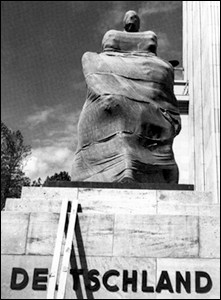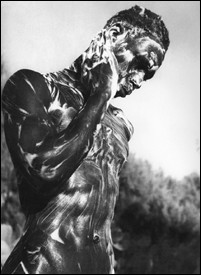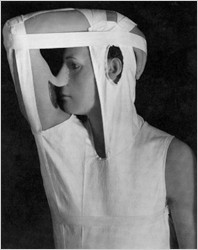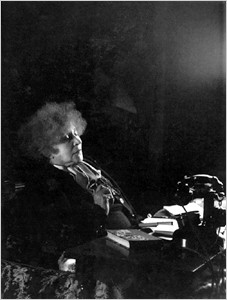 |
February, 2001
HERBERT LIST: The Magic Eye
Photographs by Herbert List
Ignored by major photography historians, little known in the
United States beyond a circle of collectors, Herbert List, a
Munich-born photographer who died in 1975, is now on his way
to being recognized as one of the most important photographers
of the last century. List's oeuvre, accomplished from the 1930s
to the mid-1960s, looked for a synthesis between antique and
modern life, or more precisely a renaissance of antiquity within
the spirit of the mechanical age.
List's recent recognition is due in large part to Max Scheler,
his friend of many years and his executor who helped assemble
a retrospective book and companion exhibition of List's best
photographs. It is now hosted at the Ivam/Centro Julio Gonzales
in Valencia, Spain, soon to travel to France, Italy, Canada
and the United States.
The various sections of the book and exhibition reflect different
periods and creative modes of List's work, from a surrealism,
expressed in landscapes and still lifes, that evokes Manuel
Alvarez Bravo, to a metaphysical mode close to De Chirico. List's
relationship to the world of archeology and a Hellenic human
ideal brings to mind his close friend George Hoyningen-Huene,
while some of his documentarywork is close to early Henri Cartier-Bresson
and Italian neo-realist films.
|
 |
|
 |
After the war List joined the Magnum photo agency for a short
time and dedicated himself to reportage without relinquishing
his sense of ironic distance and absence of moral judgement.
Like his colleagues Henri Cartier-Bresson, Ernst Haas, Werner
Bischof and David "Chim" Seymour, he published many magazine
essays. For example, in Du magazine List published portfolios
on the Caribbean (1958), Mexico (1960), Naples (1962) and Berlin
(1966). But List preferred the book format to magazines. Always
a reticent artist not prone to self-publicizing, in his later
years he abandoned photography and dedicated himself to his
collection of Italian mannerist and baroque drawings.
Beyond aesthetic categories, it is only fair to encompass the
whole of an artist who wanted to reconcile intelligence and
emotion: "A photograph," he wrote, "could be the fruit of a
sudden intuition or a shrewd reflection." Whether his images
were generated by one or the other, what they have in common
is a sense of mystery, of a secret shared beyond appearance.
These ruins, are they part of an antique Greek temple or are
they the destroyed library of his native Munich under Allied
bombs? What vision do we glimpse within these abandoned glasses
on a table? What were the three embraced youths whispering in
this summer of 1933 on a Baltic beach? Why does the soap lather
on this black athlete's body resemble the foam on this wave's
crest? What was on Picasso's mind when in 1938 he posed for
List in front of an almost finished painting?
List's erotic scenes, private until the 1988 publication of
Sons of Light, continue the homoerotic tradition of Von Gloeden
and Hoyningen-Huene. But they do not objectify their subjects:
tenderness and reserve are shown in the young men's faces, and
the play of light and shadows softens their bodies' perfection.
|
As
a portraitist, List is also remarkable: he captured the faces
of the artists he knew such as Giacometti, Braque, Stravinsky
and many others. The resulting pictures demonstrate his empathy
and his capacity for extreme discretion. In front of him the
famous do not pose; they let their guard down. Surrounded by
the frizzy halo of her hair, Colette stares at a telephone that
does not ring. In the Naples harbor, among sailors, Vittorio
de Sica has fallen asleep, his right hand holding his raincoat
collar to his cheek.
Mysterious as it remains, List's world is not a private world
of fantasies. Close to the surface we can decipher multiple
and complex undercurrents. Like the Romantic poets, List was
always preoccupied with signs from the unknown that can emerge
from in-between appearances. The insisting presence of our world's
mystery is what keeps his photography alive.
Carole Naggar
|
 |

|
Above:
Germany On The March, Paris, 1937
Love 1, Hammamet, 1934
Transplant, Vienna, 1944
Colette With Phone, Paris, 1948
|

|
|


